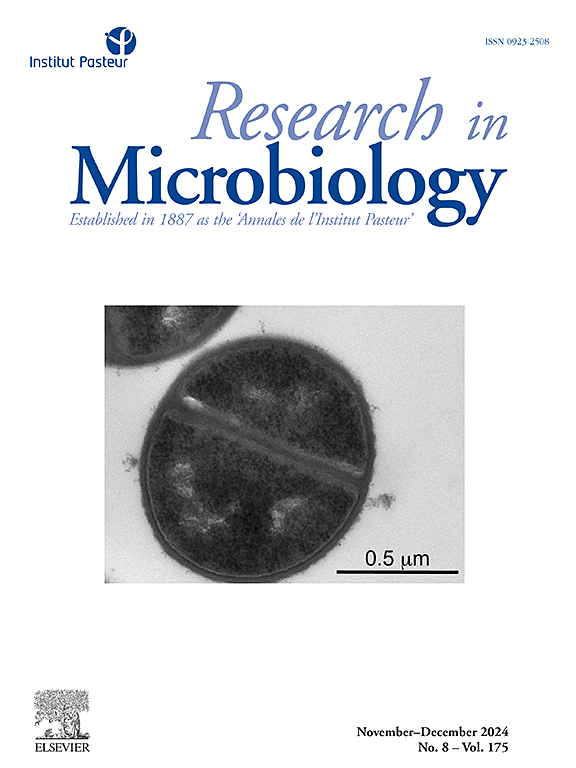MibR和LibR参与巴西氮螺旋菌Sp7中ipdC基因的转录调控。
IF 3.4
4区 生物学
Q3 MICROBIOLOGY
引用次数: 0
摘要
Azospirillum brasilense是一种产生植物激素IAA的PGPR, IAA是一种参与细菌-植物相互作用过程的信号分子。氮螺旋藻IAA的生物合成主要通过IPyA途径进行,其中ipdC基因编码的苯丙酮酸脱羧酶是主要途径。ipdC基因启动子区含有在不同氮螺旋菌株间高度保守的顺式元件。在这项工作中,我们鉴定了两种与ipdC基因启动子区域相互作用的蛋白,分别属于MarR和LuxR转录调控家族,称为MibR和LibR。这两种蛋白都有一个HTH结构域,在LibR的情况下,它有一个REC结构域,在位置7,8和54中保留了天冬氨酸残基,这是一个可能的磷酸化目标。为了探索它们在ipdC基因调控中的作用,我们产生了libR、mibR和libR-mibR双突变体。结果表明,与野生型相比,双突变体IAA生物合成的减少主要与ipdC基因表达的减少有关。本研究表明,ipdC转录受到LibR和MibR的调控,为巴西芽孢杆菌控制IAA生物合成的机制提供了新的发现。本文章由计算机程序翻译,如有差异,请以英文原文为准。
MibR and LibR are involved in the transcriptional regulation of the ipdC gene in Azospirillum brasilense Sp7
Azospirillum brasilense is a PGPR that produces the phytohormone IAA, a signaling molecule involved in bacteria-plant interaction processes. IAA biosynthesis in Azospirillum is mainly carried out via the IPyA pathway in which the enzyme phenylpyruvate decarboxylase encoded by the ipdC gene is the main. The promoter region of ipdC gene contains cis elements that are highly conserved among different Azospirillum strains. In this work, we identified two proteins that interact with the promoter region of the ipdC gene, named MibR and LibR that belong to the MarR and LuxR transcriptional regulators family, respectively. Both proteins have an HTH domain, and in the case of LibR, it has a REC domain, with aspartic acid residue conserved in positions 7, 8 and 54, this last as a possible phosphorylation target. To explore their participation in the regulation of the ipdC gene, mutants of libR, mibR, and libR-mibR double mutant were generated. The results showed a decrease in IAA biosynthesis that was related to the observed decrease in ipdC gene expression mostly in the doble mutant compared with the wild type. In this work we suggest that ipdC transcription is regulated by LibR and MibR, providing new findings insight into the mechanism employed by A. brasilense to control IAA biosynthesis.
求助全文
通过发布文献求助,成功后即可免费获取论文全文。
去求助
来源期刊

Research in microbiology
生物-微生物学
CiteScore
4.10
自引率
3.80%
发文量
54
审稿时长
16 days
期刊介绍:
Research in Microbiology is the direct descendant of the original Pasteur periodical entitled Annales de l''Institut Pasteur, created in 1887 by Emile Duclaux under the patronage of Louis Pasteur. The Editorial Committee included Chamberland, Grancher, Nocard, Roux and Straus, and the first issue began with Louis Pasteur''s "Lettre sur la Rage" which clearly defines the spirit of the journal:"You have informed me, my dear Duclaux, that you intend to start a monthly collection of articles entitled "Annales de l''Institut Pasteur". You will be rendering a service that will be appreciated by the ever increasing number of young scientists who are attracted to microbiological studies. In your Annales, our laboratory research will of course occupy a central position, but the work from outside groups that you intend to publish will be a source of competitive stimulation for all of us."That first volume included 53 articles as well as critical reviews and book reviews. From that time on, the Annales appeared regularly every month, without interruption, even during the two world wars. Although the journal has undergone many changes over the past 100 years (in the title, the format, the language) reflecting the evolution in scientific publishing, it has consistently maintained the Pasteur tradition by publishing original reports on all aspects of microbiology.
 求助内容:
求助内容: 应助结果提醒方式:
应助结果提醒方式:


